
The term “cardboard box” is commonly misused when referring to a corrugated box. The correct technical term is “corrugated fiberboard carton.”
Cardboard boxes are a thin, stiff pasteboard used in the creation of playing cards, signs, etc. The term is often misused to refer to Boxboard (folding cartons) and Containerboard (corrugated boxes).
Corrugated fiberboard boxes are widely utilized in retail packaging, shipping cartons, product displays, and many other applications requiring a lightweight, but sturdy material.
Corrugated Composition
Corrugated fiberboard is comprised of Linerboard and Medium. Linerboard is the flat, outer surface that adheres to the Medium. The Medium is the wavy, fluted paper between the liners. Both are made of a special kind of papers called containerboard. Board strength will vary depending on the various Linerboard and Medium combinations.

- (A) Single Face: One corrugated Medium is glued to one flat sheet of Linerboard; flutes exposed.
- (B) Single Wall: The corrugated Medium is glued between two sheets of Linerboard. Also known as doubleface.
- (C) Double Wall: Three sheets of Linerboard with two Mediums in between.
- (D) Triple Wall: Four sheets of Linerboard with three Mediums in between.
Flute Facts
Corrugated board can be created with several different flute profiles. Generally, larger flute profiles deliver greater vertical compression strength and cushioning. Smaller flute profiles provide enhanced structural and graphics capabilities for use in retail packaging.

- A-Flute: Appx 33 flutes per foot. Original corrugated flute design.
- B-Flute: Appx 47 flutes per foot and measures 1/8″ thick; often for canned goods.
- C-Flute: Appx 39 flutes per foot and measures 5/32″ thick; common for shipping cartons.
- E-Flute: Appx 90 flutes per foot and measures 1/16″ thick.
- F-Flute: Appx 125 flutes per foot and measures 1/32″ thick; for small retail packaging.
Different flute profiles can be combined in one piece of combined board. For example, a triple wall board may contain one layer of A-flute Medium with two layers of C-flute Medium. Mixing flute profiles allows designers to adjust compression strength, cushioning strength, and the total thickness of the combined board.
How to Measure a Box
The length is always the longer dimension, and the width is always the shortest dimension, measured along the opening of the box. The depth is the distance between the opening and the opposite panel.
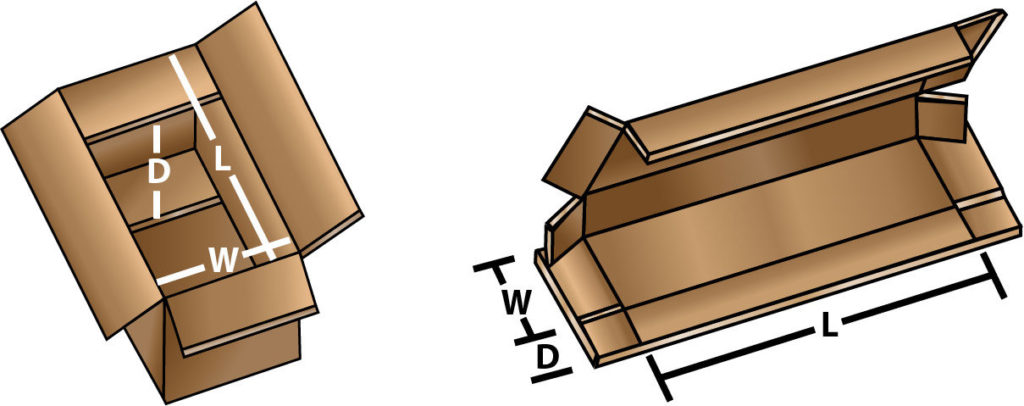
In the industry, boxes are always measured from the inside, with the dimensions referring to the opening of an assembled box. Inside dimensions are used for measuring because the corrugated board thickness may vary. A box constructed of B flute will not have the same outer dimensions as a box made from A flute.
Outer dimensions may need to be communicated for shipping and pallet configuration purposes. When listing outer dimensions, always include “OD” with the size (e.g., 10″x22″x12″ OD).
Box Style Definitions and Abbreviations
The majority of box styles fall into one of the following general categories: Slotted Boxes, Telescope Boxes, Folders, Rigid (or Bliss) Boxes, Self-Erecting Boxes, and Interior Forms. In addition, corrugated boxes can be custom-designed to meet the specific needs of the customer.
Slotted Boxes
These boxes are generally made from a single piece of corrugated fiberboard. The blank is scored and slotted to permit folding. Boxes are shipped and stored flat and assembled as needed by the user. Some of the most common types include:
- Regular Slotted Container (RSC) – All flaps have the same length, and the two out flaps are one-half the container’s width so that they meet at the center of the box when folded. The RSC is the most common box style.

- Half Slotted Container (HSC) — Same as a Regular Slotted Container (RSC), but without one set of flaps.

- Overlap Slotted Container (OSC) — All flaps have the same length; the outer flaps overlap by one inch or more. The box is usually closed with staples driven through the overlap area. This style of box is used when the length of the box is considerably greater than the width, resulting in a long gap between the inner flaps. The sealed overlap helps to keep the outer flaps from pulling apart.

- Full overlap Slotted Container (FOL) — All flaps have the same length (the width of the box). When closed, the outer flaps come within one inch of complete overlap. This style is especially resistant to rough handling and provides extra product cushioning and stacking strength.

- Center Special Slotted Container (CSSC) — Inner and outer flaps are cut to different lengths. Both sets of flaps meet at the center of the box. This style is especially strong because both the top and bottom have double the thickness of corrugated board. The inner flaps, with no gap, provide a level base for products.

- Center Special Full Overlap Slotted Container (SFF) — Inner and outer flaps are cut to different lengths. When closed, the inner flaps meet at the center of the box, and out flaps fully overlap. With three full layers of combined board over the entire top and bottom, this style provides extra cushioning and stacking strength.

Telescope Boxes
These boxes usually consist of top and bottom pieces that fit over each other. “Telescope Style” generally describes a box where the cover extends over at least two-thirds of the depth of the bottom piece, where a Box with Cover indicates a box where the cover extends less than two-thirds of the depth. Common types include:
- Full Telescope Design Style Container (FTD) and Design Style Container with Cover (DSC) — Two-piece boxes made from two scored and slotted blanks (trays).

- Full Telescope Half Slotted Container (FTHS) — The two-piece body is made from two half-slotted containers.

Rigid (Bliss) Boxes
Rigid Boxes include two identical end panels and a body that folds to form the two side panels, an unbroken bottom, and the top. Flaps are used to form the joints. Once the joints are sealed, the box is considered rigid.
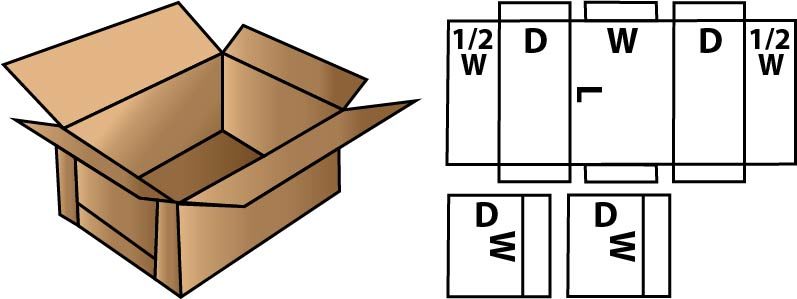
Self-erecting Boxes
Self-Erecting Boxes typically feature regular slotted container, or telescope-style tops.
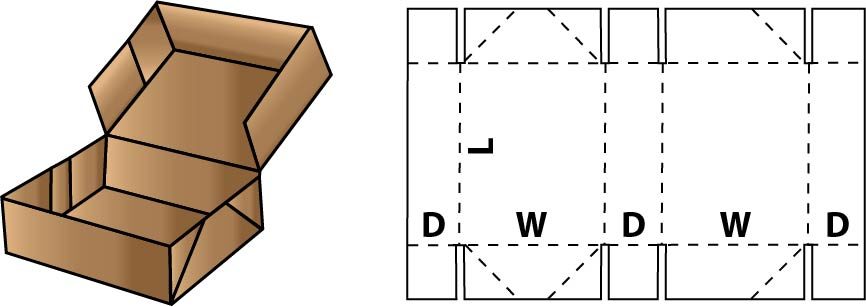
Folders
These consist of one or more pieces of combined board, with an unbroken bottom surface and scored to fold around the product. Popular styles include:
- One Piece Folder (OPF) — One piece of board is cut so that it provides a flat bottom, with flaps forming the sides and ends, and extensions of the side flaps meeting to form the top.
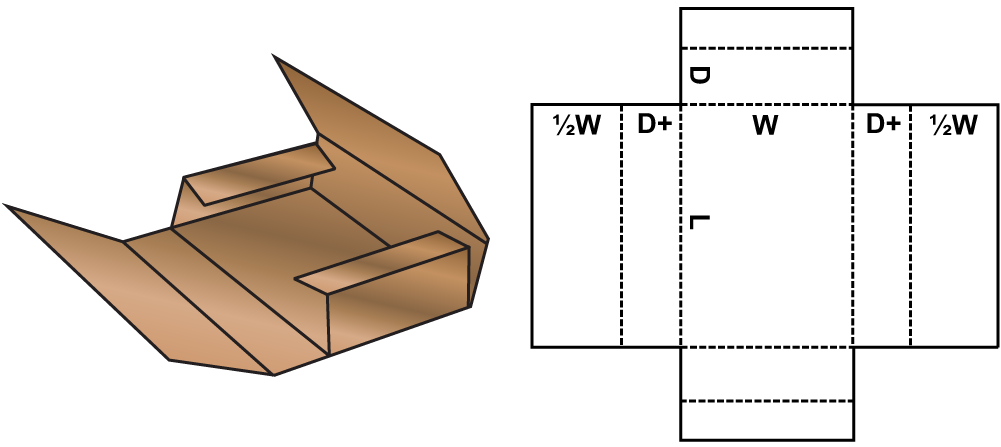
- Five Panel Folder (FPF) — A single cut and scored piece features a fifth panel used as the closing flap, completely covering a side panel.
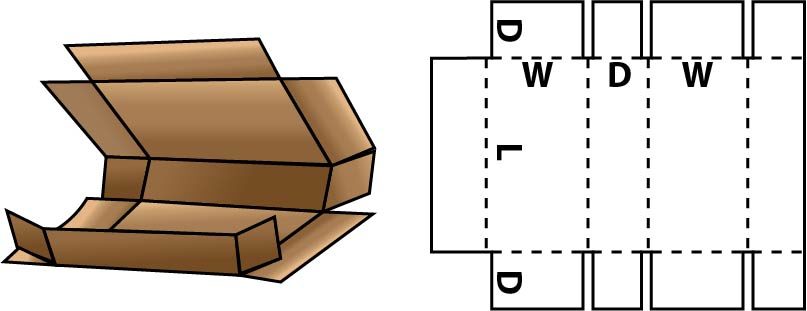
- Trays are formed from a single piece of combined board, with the design featuring an unbroken bottom and several layers of corrugated in the end panels. They are frequently used as inner containers for parts, delicate produce, or mail pieces.

Interior Forms
These include a wide variety of build-ups, dividers, partitions and other inner packing pieces. They can be used to separate or cushion products, to strengthen the box or to fill voids. They may be simple rectangle, scored, slotted or die-cut shapes. Common formats include:
- Pads are plain shapes of corrugated or solid fiberboard, used to fill spaces or separate layers or sections of products.
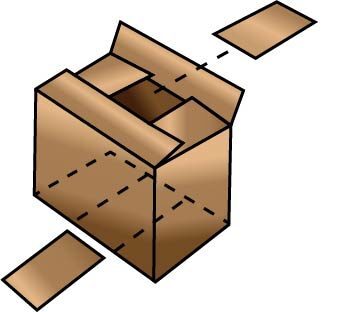
- Tubes are scored rectangles, folded to form a multi-sided structure.

-
Partitions (or Dividers) provide a separate cell for each item in a box. Primarily used for packaging glassware or other fragile items.

- Inner Packing Pieces are scored and/or folded pieces of corrugated used for cushioning, suspension, and separation, and to fill voids.

- Inner Pack Forms are usually die cut corrugated pieces designed to position and support products away from the walls of the box for added protection.
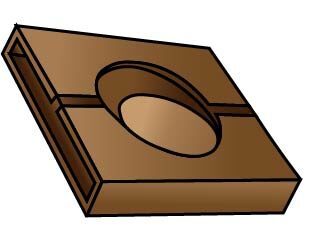
Box Certificates
The Mullen Bursting Test measures a box’s ability to withstand external or internal forces and to contain the contents during handling. The test certifies that the box can withstand the stated pressure (lbs. per sq. in.) as applied by a Mullen Tester.
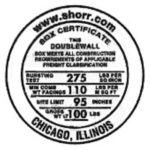
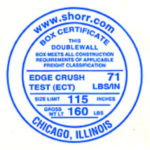
The Edge Crush Test measures the amount of force (lbs. per in.) needed to cause the compressive failure of an on-edge specimen of corrugated board. The result is a primary factor in determining the compression strength of a completed box.
Fiberboard Performance Standards
SINGLE WALL
| Max Wt. Box/Contents (lbs.) |
Min. Burst Test (lbs. per sq. in) |
Min. Edge Crush Test (lbs. per in. width) |
| 20 | 125 | 23 |
| 35 | 150 | 26 |
| 65 | 175 | 29 |
| 80 | 200 | 32 |
| 90 | 250 | 40 |
| 95 | 275 | 44 |
| 120 | 350 | 55 |
DOUBLE WALL
| Max Wt. Box/Contents (lbs.) |
Min. Burst Test (lbs. per sq. in) |
Min. Edge Crush Test (lbs. per in. width) |
| 80 | 200 | 42 |
| 100 | 275 | 48 |
| 120 | 350 | 51 |
| 140 | 400 | 61 |
| 160 | 500 | 71 |
| 180 | 600 | 82 |
TRIPLE WALL (minimum puncture test, oz. per in. of tear)
| Max Wt. Box/Contents (lbs.) |
Puncture Test (inch, oz. of force per in.) |
Min. Edge Crush Test (lbs. per in. width) |
| 240 | 700 | 67 |
| 260 | 900 | 80 |
| 280 | 1100 | 90 |
| 300 | 1300 | 112 |
Glossary of Terms
- Adhesive: The substance used to hold plies of solid fiberboard together, to hold Linerboard to the tips of flutes of corrugated Medium, or to hold overlapping flaps together to form the joint or to close a box.
- Bale: A shaped unit of materials, enclosed in a fiberboard container or other wrapping, bound by strapping, rope, or wire.
- Basis Weight: An attribute of containerboard, but the values may be determined from the combined corrugated board. When determining the basis weight from the combined board, the take-up factor of the corrugated Medium, which varies with flute size, and the weight of the adhesive must be considered.
- Bending: The ability of containerboard or combined board to be folded along scorelines without rupture of the surface fibers to the point of seriously weakening the structure.
- Blank or Box Blank: A flat sheet of corrugated board that has been cut, scored, and slotted, but not yet glued together.
- Box Manufacturer: An establishment that has equipment to score, slot, print, and join corrugated or solid fiberboard sheets into boxes, and that regularly uses that equipment in the production of fiberboard boxes in commercial quantities.
- Box Manufacturer’s Certificate (BMC): A statement printed in a round or rectangular design on a corrugated box flap that certifies the box conforms to all applicable standards, and identifies its manufacturer. Sometimes referred to as a class stamp or cert stamp.
- Box Style: Distinctive configuration of a box design, without regard to size. A name or number identifies styles in common use.
- Boxboard: The types of paperboard used to manufacture folding cartons and set up (rigid) boxes.
- Built-up: Multiple layers of corrugated board glued together to form a pad of desired thickness, normally used for interior packing.
- Bulk: Unpackaged goods within a shipping container. Also, a large box is used to contain a volume of product (e.g., “bulk box”).
- Bundle: A shipping unit of two or more articles or boxes wrapped or fastened together by suitable means.
- Caliper: Usually expressed in thousandths of an inch (mils) or sometimes referred to as “points.” Caliper measurements are also used as an indirect measure of manufacturing quality.
- Cardboard: A thin, stiff pasteboard used in the creation of playing cards, signs, etc. The term is often misused to refer to Boxboard (folding cartons) and Containerboard (corrugated boxes).
- Carton: A folding box made from boxboard, used for consumer quantities of product. A carton is not recognized as a shipping container.
- Case: As used by the packaging industry, a corrugated or solid fiberboard box.
- Chipboard: A paperboard generally made from recycled paper stock. Uses include backing sheets for padded writing paper, partitions within boxes, and the center ply or plies of solid fiberboard.
- Combined Board: A fabricated sheet assembled from several components, such as corrugated or solid fiberboard.
- Compression Strength: A corrugated box’s resistance to uniformly applied external forces. Top-to-bottom compression strength is related to the load a container may encounter when stacked. End-to-end or side-to-side compression may also be of interest for particular applications.
- Containerboard: The paperboard components (Linerboard, corrugating material, and chipboard) used to manufacture corrugated and solid fiberboard. The raw materials used to make containerboard may be virgin cellulose fiber, recycled fiber, or a combination.
- Corrugated Board, Corrugated Fiberboard: The structure formed by gluing one or more sheets of fluted corrugating Medium to one or more flat facings of Linerboard. There are four common types:
- Single Face: Combination of one fluted corrugating Medium glued to one flat facing of Linerboard.
- Single Wall: Two flat facings of Linerboard, one glued to each side of a corrugated Medium. Also known as Double Face.
- Double Wall: Three flat facings of Linerboard, one glued to each side of two corrugated Mediums.
- Triple Wall: Four flat facings of Linerboard, one glued to each side of three corrugated Mediums.
- Corrugator: The machine that unwinds two or more continuous sheets of containerboard from rolls, presses flutes into the sheet(s) of corrugating Medium, applies adhesive to the tips of the flutes, and affixes the sheet(s) of Linerboard to form corrugated board. The continuous sheet of board may be slit to desired widths, cut off to desired lengths, and scored in one direction.
- Design Style: A style of fiberboard trays or caps having flaps scored, folded, and secured at flange side walls forming the depth, as opposed to a slotted style having a set of major and minor closing flaps.
- Die Cut: The act of cutting raw material (such as combined board) to a desired shape (such as a box blank) by using a die.
- Dimensions: The three measurements of a box: length, width, and depth. Inside dimensions are used to assure proper fit around a product. Outside dimensions are used in the carrier classifications and in determining pallet patterns.
- Double Wall: A corrugated board construction where two layers of Medium are glued between three layers of flat Linerboard facing.
- Edge Crush Resistance/Short Column Compression (ECT): The amount of force needed to crush on-edge combined board is a primary factor in predicting the compression strength of the completed box. When using certain specifications in the carrier classifications, minimum edge crush values must be certified.
- Facings: Sheets of Linerboard used as the flat outer members of combined corrugated board. Sometimes called inside and outside liners.
- Fiberboard: A general term describing combined paperboard (corrugated or solid) used to manufacture containers.
- Flaps: Extension of the side wall panels that, when sealed, close the remaining openings of a box. Usually defined by one scoreline and three edges.
- Flexo Folder Gluer: A machine, usually capable or running at high speed that prints, folds, cuts, and glues sheets of corrugated board, converting them into shipping boxes.
- Flute: The wavy layer of corrugated Medium that is glued between the flat inner and outer sheets of Linerboard to create corrugated board. Fluting generally runs parallel to the height of a shipping box.
- Joint: The opposite edges of the blank glued, stapled, wire stitched, or taped together to form a box.
- Kraft: German word meaning “strength”; designating pulp, paper, or paperboard produced from wood fibers.
- Liner: A creased fiberboard sheet inserted as a sleeve in a container and covering all side walls. Used to provide extra stacking strength or cushioning.
- Linerboard: The flat sheets of paper that comprise the outer surfaces of a sheet of corrugated board.
- Medium: The paperboard used to make the fluted layer of corrugated board.
- Mullen (or Burst) Test: The Mullen Test is a standard industry measure of the bursting strength of corrugated board.
- Overlap: A design feature wherein the top and/or bottom flaps of a box do not butt, but extend one over the other. The amount of overlap is measured from flap edge to flap edge.
- Pad: A corrugated or solid fiberboard sheet, or sheet of other authorized material, used for extra protection or for separating tiers or layers of articles when packed for shipment.
- Palletizing: Securing and loading containers on pallets for shipment as a single unit load, typically for handling by mechanical equipment.
- Panel: A “face” or “side” of a box.
- Paperboard: One of the two major product categories of the paper industry. Includes the broad classification of materials made of cellulose fibers, primarily wood pulp and recycled paper stock, on board machines. The major types are containerboard and boxboard. (The other major product group of the paper industry is paper, including printing and writing papers, packaging papers, newsprint, and tissue.)
- Partition: A set of corrugated, solid fiberboard or chipboard pieces that interlock when assembled to form a number of cells into which articles may be placed for shipment.
- Ply: Any of the several layers of Linerboard or solid fiberboard.
- Point: Term used to describe the thickness or caliper of paperboard, where one point equals one-thousandth of an inch.
- Puncture Resistance: The puncture resistance of the combined board indicates the ability of the finished container to withstand external and internal point pressure forces and to protect the product during rough handling. This method is used on heavy double wall and triple wall as an alternative to burst.
- Regular Slotted Container (RSC): A box style created from a single sheet of corrugated board. The sheet is scored and slotted to permit folding. Flaps extending from the side and end panels form the top and bottom of the box. The two outer flaps are one-half the container’s width to meet at the center of the box when folded. Flute direction may be perpendicular to the length of the sheet (usually for top-opening RSCs) or parallel to the length of the sheet (usually for end-opening RSCs).
- Score or Scoreline: An impression or crease in corrugated or solid fiberboard, made to position and facilitate folds.
- Scored and Slotted Sheet: A sheet of corrugated fiberboard with one or more scorelines, slots, or slits. May be further defined as a box blank, a box part, a tray or wrap, a partition piece, or an inner packing piece.
- Seam: The junction created by any free edge of a container flap or panel where it abuts or rests on another portion of the container and to which it may be fastened by tape, stitches, or adhesive in the process of closing the container.
- Set-up Boxes: Boxes that have been squared, with one set of end flaps sealed, ready to be filled with product. An article that is packed for shipment in a fully assembled or erected form.
- Sheet: A rectangle of combined board, untrimmed or trimmed, and sometimes scored across the corrugations when that operation is done on the corrugator. Also, a rectangle of any of the component layers of containerboard, or of paper, or a web of paperboard as it is being unwound from the roll.
- Slit: A cut made in a fiberboard sheet without removal of material.
- Slit Score: Shallow knife cuts made in a box blank to allow its flaps and sides to be folded into a shipping box.
- Slip Sheet: A flat sheet of material used as a base upon which goods and materials may be assembled, stored, and transported.
- Slot: A wide cut, or pair of closely spaced parallel cuts including removal of a narrow strip of material made in a fiberboard sheet, usually to form flaps and permit folding without bulges caused by the thickness of the material. Common widths are 1/4 in. (6 mm) and 3/8 in. (9 mm).
- Stacking Strength: The maximum compressive load a container can bear over a given length of time, under given environmental/distribution conditions, without failing.
- Tensile Strength: Indicates the containerboard’s resistance to breaking when it is pulled into or through equipment during the converting and printing processes.
- Tube: A sheet of combined boards, scored and folded to a multi-sided form with open ends. It may be an element of a box style or a unit of interior packing that provides protection and compression strength.
- Unit: A large group of bundled or unbundled boxes, banded and/or stretch filmed together for shipment.
- Unitized Load: A load of a number of articles or containers, bound together by means of tension strapping, plastic shrink or stretch films.
- Web: A continuous sheet of paperboard or paper.
- Wrap-around Blank: A scored and slotted sheet of corrugated fiberboard that is formed into a box by folding it around its contents. The user makes both the flap and joint closures.
